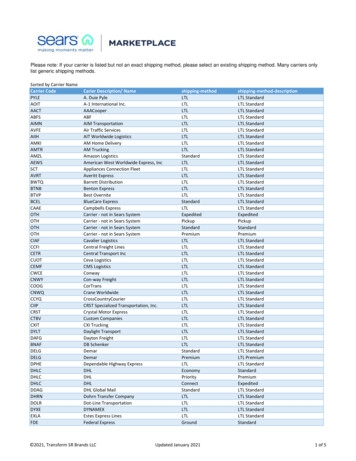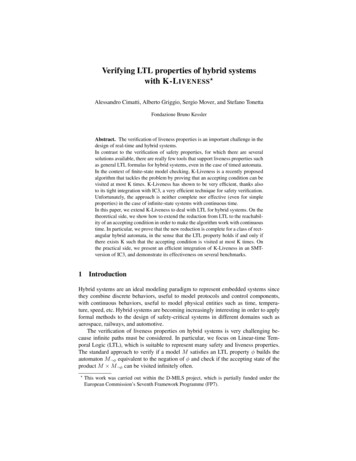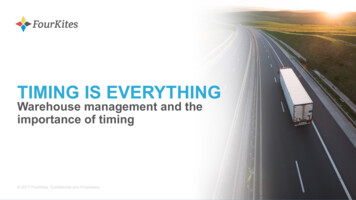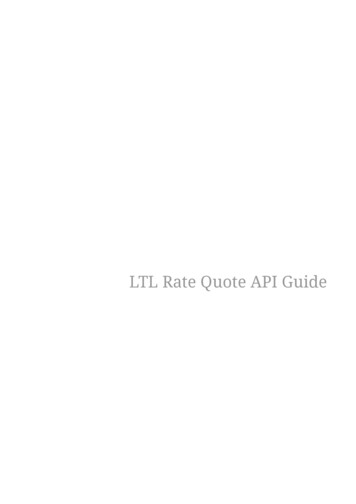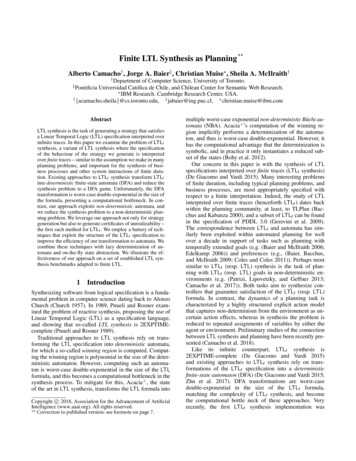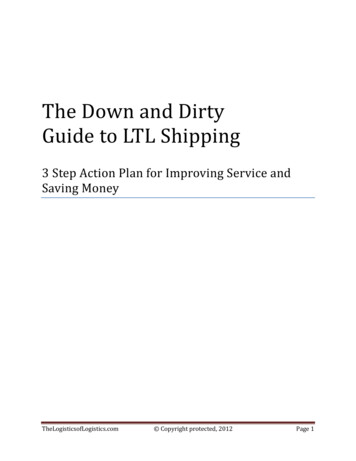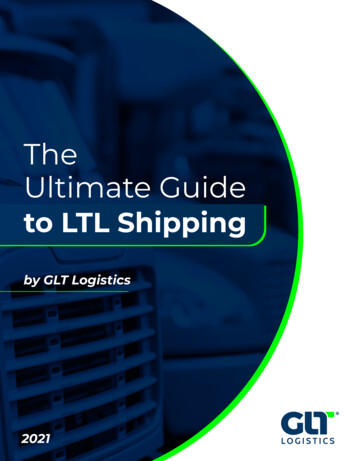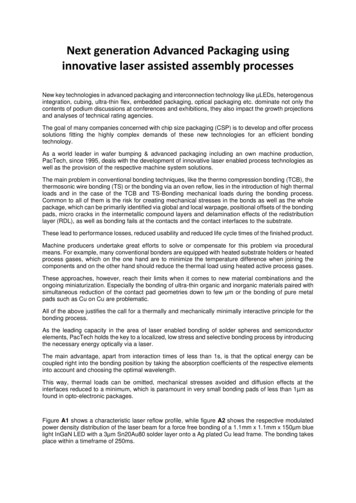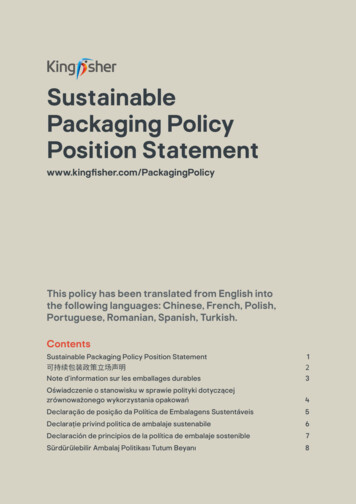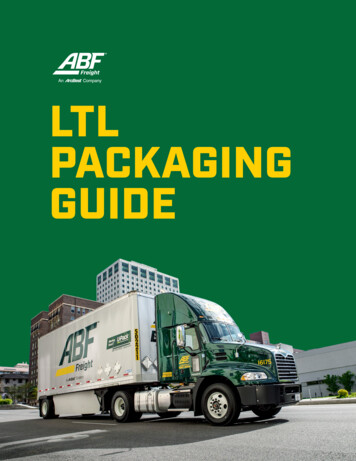
Transcription
LTLPACKAGINGGUIDE
YOURFREIGHT ISIMPORTANT.KEEP ITSAFE.At ABF Freight , we’re proud of our low claims rate. We take a lot of pride intreating customers’ goods as our own during transport. But even so, less-thantruckload (LTL) shipments are subject to potential hazards such as shock, vibration,compression, temperature and humidity. The severity of these factors will dependon road conditions, interactions with other freight, equipment and weather duringtransit, but their effects can be lessened with proper packaging materials.1
QUICK TIPSPACKAGINGProtect freight in the LTL environmentMeet or exceed the minimum packaging requirements outlined in the National MotorFreight Classification (NMFC)Use proper packaging materialsPREPARATIONCorrectly secure freight to palletsStack boxes for optimum strength and stabilityUse tie sheets and corner boards to avoid shifting and column collapseChock and strap freight to prevent movementApply stretch film to keep items containedCrate items when necessaryBlock, brace and cushion all material inside the crateUse diagonal boards or panels to increase crate strengthLabel all handling pieces in the shipmentDOCUMENTATIONInclude an accurate Bill of Lading to avoid billing errorsNumber of pallets or pieces being shippedShipment description and dimensions for each unitNMFC numberWeight of each handling unitPICKUPTo request pickup you’ll need to know:Origin and destination locationsRequested time and date for pickupContact informationShipment detailsSpecial handling requests2
THE LTL ENVIRONMENTAs freight is handled and transported over the road, it will be exposed to various elements.SHOCKOccurs during situations such as driving over speedbumps and potholes, braking or handling with a forklift.VIBRATIONPresent at most times during road transportation.COMPRESSIONCan be caused from stacking, straps, load shifting, and driving behaviors such as turning corners and braking.EXPOSURENormal conditions include temperature and humidity changes, dirt, odor and condensation.Minimum packaging requirements are specified within a given NMFC itemnumber to ensure freight can withstand the normal LTL environment. Keepshipments safe by meeting or exceeding those requirements.121,20012 LBSIs the average cubic density of freight in the LTL environment.1,200 LBSIs the average weight of an ABF Freight shipment.3
INTERNAL PROTECTIONTo protect freight from transportation hazards, it’s often necessary to use internal packagingmaterials to help guard against environmental changes and help prevent shifting.Sheet foamFlexible foam that can be easily wrapped around freight to keep it protected.Plank foamThick square or rectangular pieces that help cushion and stabilize itemswithin a box.Molded foamCustomized foam pieces designed specifically for a certain item.Foam-in PlaceFoam protection that is applied after the item is inside the box to create acustom fit.Bubble wrapLightweight and flexible packing material that helps with shock absorption.Honeycomb fiberboardStrong but lightweight paper-based structure ideal for placing betweenstacked items.Layered corrugated fiberboardOccurs during situations such as driving over speedbumps and potholes,braking or handling with a forklift.Molded pulpPaper-based packing material designed to fit a certain item.4
EXTERNAL PROTECTIONMost shipments require the use of external packaging materials to promote safe handling practices.Corrugated fiberboard boxesThe most common container for shipping products from manufacturing tothe retailer or end user.Rollerboard fiberboardFiberboard material that easily wraps around cylindrical items.Tie sheetsThin cardboard or paper sheets that increase the stability of stacked items.Corner BoardsMaterial that fits over the edges of columns to increase stability and protectedges from damage.Stretch filmClear plastic sheeting that is primarily used to secure individual itemstogether and reduce contact with dust.PalletsFlat platforms that allow goods to be easily moved by material handlingequipment.CratesWooden shipping containers that offer a high level of protection.5
SECURING LTL FREIGHTSTACKING AND PALLETIZINGMisaligned corners and pallet overhang can lead to significant loss in strength.Slight misalignment of corners12.5% loss in strengthPallet deck misalignmentPallet overhang32% loss in strengthPallets should be designed and constructed to withstand thenormal rigors of the LTL environment.A. All pallets should have a bottom deck to preventcollapse from fork tine pressureB. At least three inches of clearance is needed for palletjack access from the sideC. Long pallets should be designed with access on allsidesD. Chamfered runner boards should be at least 28 inchesapart to allow for pallet jack accessFreight should be stabilized and securely fastened to thepallet deck.A. Use tie sheets between layers of boxes and at the top andbottom of the shipment to protect against abrasion andsoilingB. Use corner boards to help keep boxes aligned, preventboxes from shifting off of the pallet, and help preventdamage from strapping and stretch wrapStrapand chock freight to the pallet to keep it fromC.shiftingcD. Use strap protectors between straps and packagingE. Avoid placing straps where forklift tines or pallet jackwheels may come in contact with them50% loss in strengthdabcadeb6
STRETCH FILM APPLICATIONUse stretch film to keep products contained on pallets and help protect shipments from externalelements. For best results, use a stretch wrapping machine and stretch the film to at least 80percent of its recommended stretch. Consult your stretch film supplier to make sure you’reapplying it properly.Stretch film is not designed to prevent damage to fragile or paintedsurfaces or protect against abrasionWRAPPING TECHNIQUEPallets should be double wrapped for optimal protection.1.Start at the bottom and move upward, overlapping layers for consistentcoverage2.Wrap around the top three times, letting two to six inches of film goover the top of the shipment3.Move downward, covering the surface again4.Wrap the bottom of the pallet two times7
CRATING GUIDELINESCrates can be fully enclosed or have a skeletal frame depending on the needs of the freight.A.Design crates to include three-way locking corners to ensure they stayintact during transit and meet the minimum NMFC requirements for acrate.B.All objects within a crate should be blocked, braced and properlycushioned to prevent damage during shipment.C.Skeletal crates should have diagonal boards angled between 30 degreesand 60 degrees to increase rigidity.D.Long crates should be designed with access on all sides and includechamfered runner boards.E.All plywood in an enclosed crate should be fully supported by solid wood.8
SCHEDULING PICKUPBILL OF LADING FORMA bill of lading (BOL) is required for all LTL shipments. Create and print BOLs online with our bill oflading tool. To avoid billing errors, include accurate information about practices.The number of pallets or pieces being shippedThe shipment’s description and dimensions for each unitThe NMFC numberThe shipment’s weight (including packaging and pallets)PICKUP REQUESTSLTL shipments can be scheduled easily online. The following information will be needed:Pickup and delivery locations. Company name and street addressTime and date for pickup. Requested pickup date and time, and dock close timeContact information. Name and phone number for the shipper and consigneeCommodity type. Shipment description and any special handling needsShipment dimensions. Number of handling units, exact dimensions and weight ofthe shipment9
LABELING GUIDELINESProperly labeling freight is the best way to prevent separation, loss and damage.Before pickup, make sure:PRO numbers and address labels are placed on all fork tine entry faces so they’re visible tothe forklift driverAll old PRO numbers and address labels are removed or coveredAt least one PRO sticker is placed next to the address labelLabels are placed on each handling piece, and each item is numbered (X of X)Freight more than 96 inches long has labels on or near both endsDOT hazardous material labels are applied to hazardous freightLabels are not required onthe top of freight unlessthey won’t fit on the sideTemperature changescan cause tape to loseadhesiveness. Apply a layerof shrink wrap over labels tokeep them in place.Use a metal or paint markerto label metal freight incase tags or labels comeoff during transit.COMMON PRECAUTIONARY LABELSUse these labels to identify freight that requires special handling:Fragile, handle with careThis way upKeep dryTop heavyProtect from freezingStrap to wallDo not fork (extra charges may apply)Did you know you can create shipment labels for your LTL freight online?Our shipping label tool will help you keep track of all required informationso shipments can be delivered accurately.10
LTL SHIPPING WITH ARCBESTAs a proven leader in the LTL industry since 1923, ArcBest carrier ABF Freight is a trustedpartner for fast, secure service in both regional and national markets. We strive for excellence inevery aspect of our industry — and it shows. From safety guidelines to sustainability programs,we’ve been recognized multiple times for our procedures and initiatives. Honors include theExcellence in Security Award and President’s Trophy for Safety by the American TruckingAssociations and the Quest for Quality Award by Logistics Management magazine.240 More than 240service centersacross NorthAmerica50 Coverage to all 50states, Canada,Mexico and PuertoRico99%Over 99 percentof ABF Freightshipments moveclaim-freeThe ABF Freight Rules Tariff governs and covers specific topics particular to ABF Freight,including but not limited to: carrier regulations, special services offered and prohibited orrestricted articles.For more details on packaging for the LTL distribution environment, please see the complete ABFFreight LTL Packaging Guidelines.11
For more details on packaging for the LTL distribution environment, please see the complete ABF Freight LTL Packaging Guidelines. LTL SHIPPING WITH ARCBEST 240 50 More than 240 service centers across North America Coverage to all 50 states, Canada, Mexico and Puerto Rico 99% Over 99 percent of ABF Freight shipments move claim-free 11
